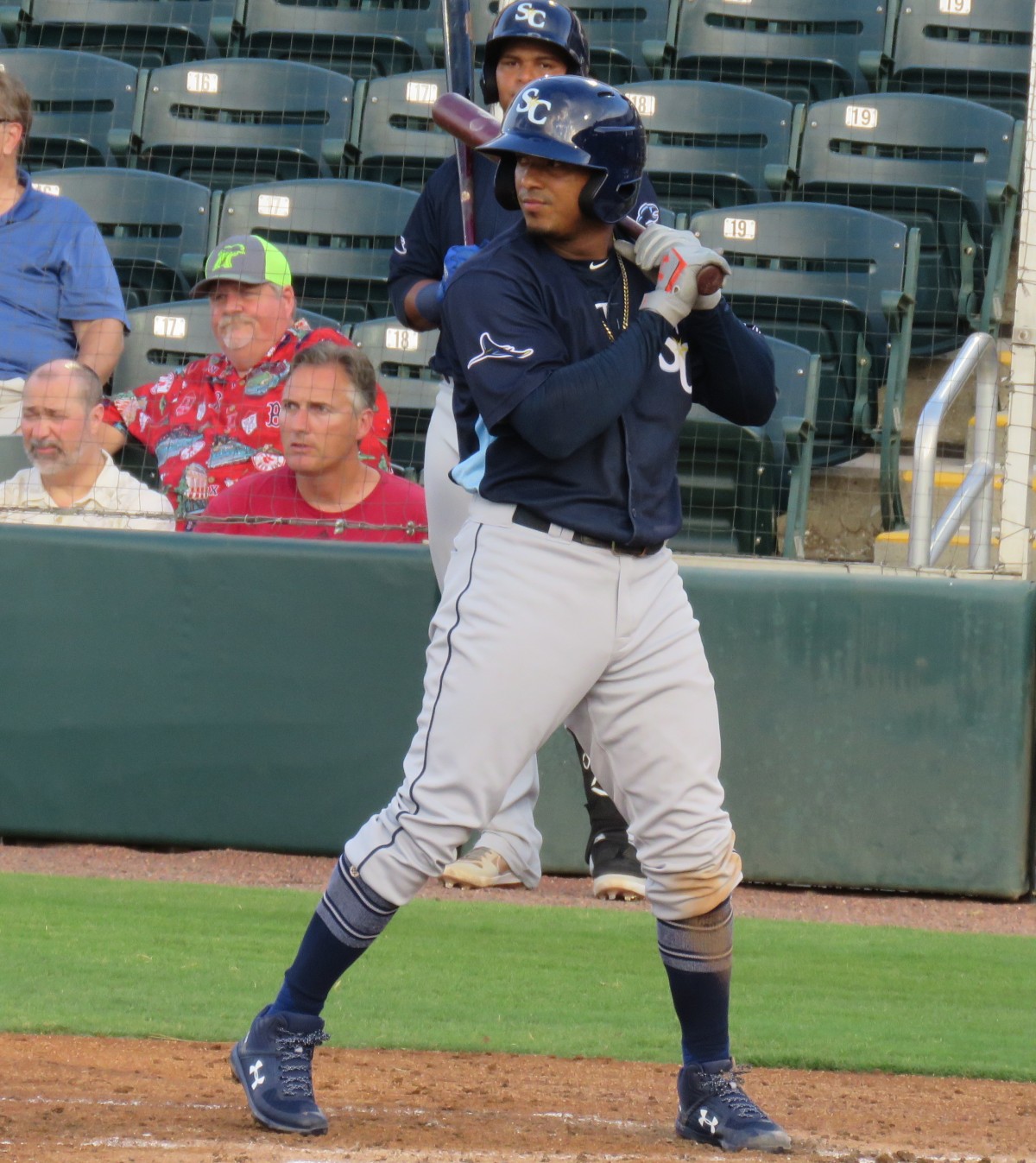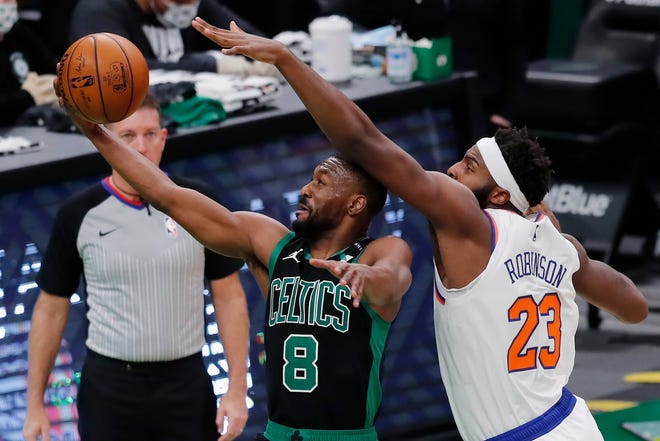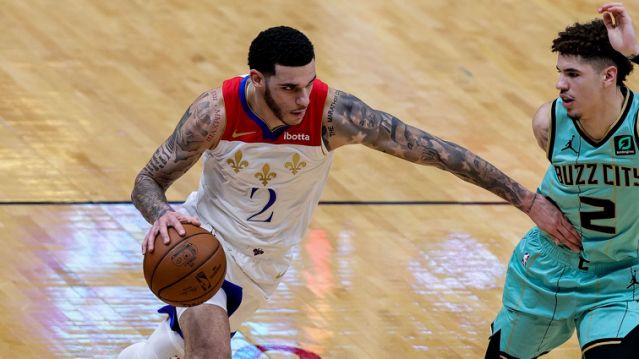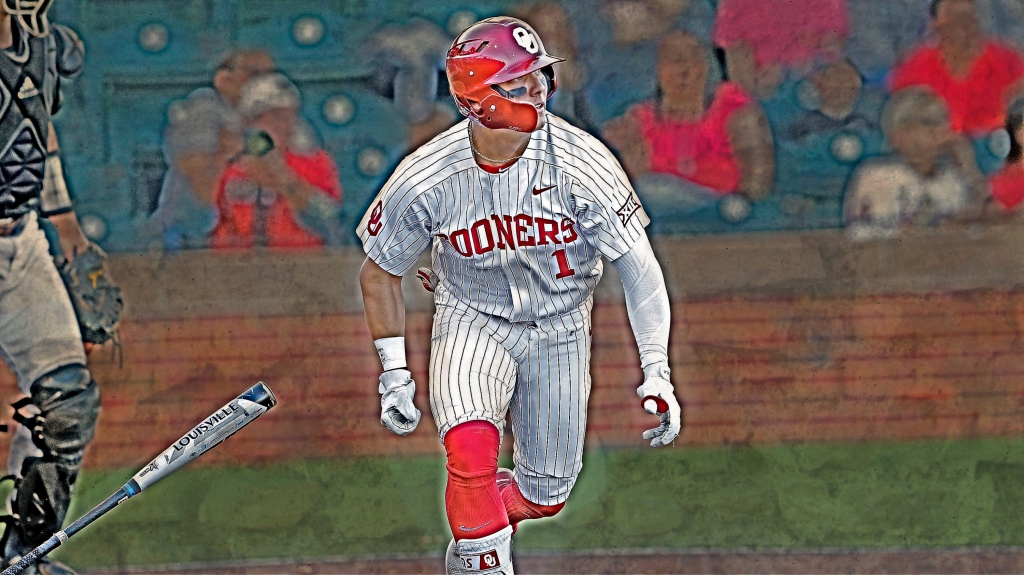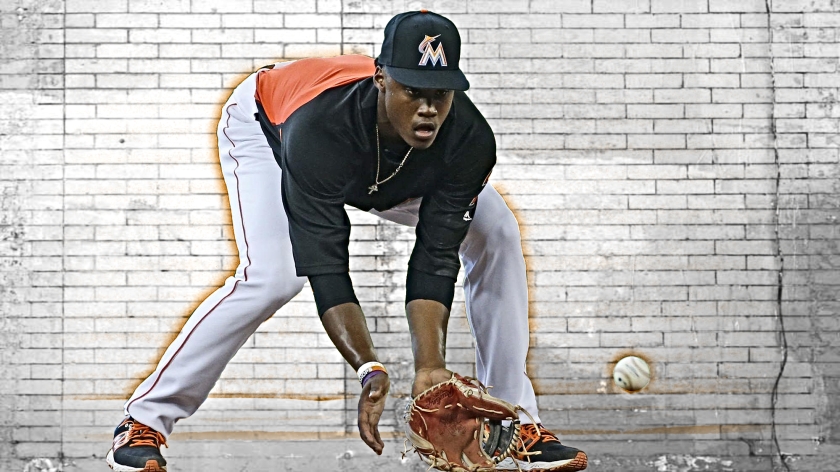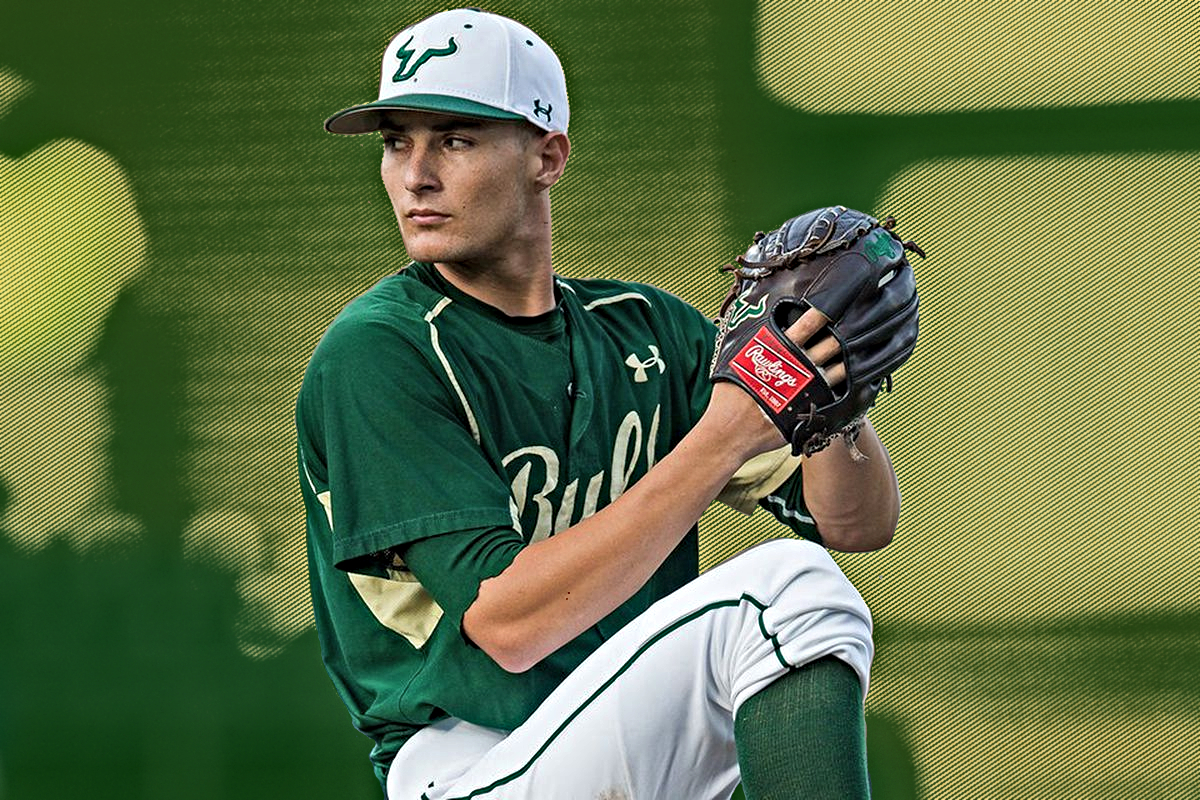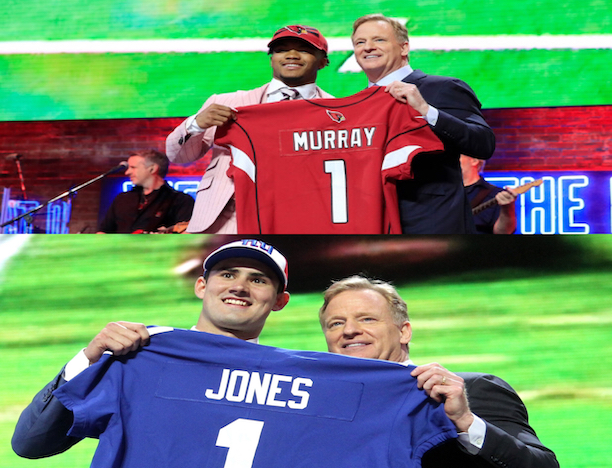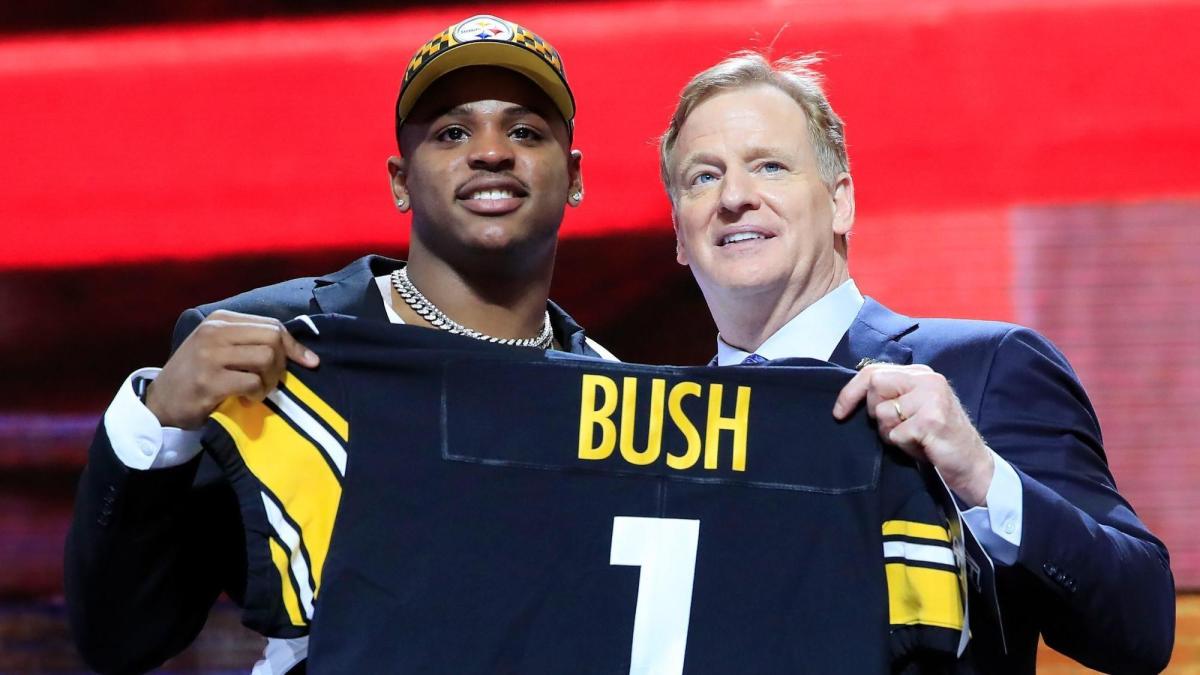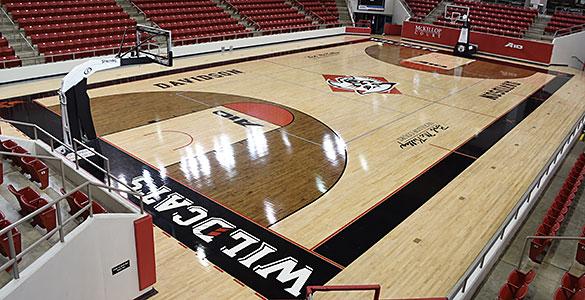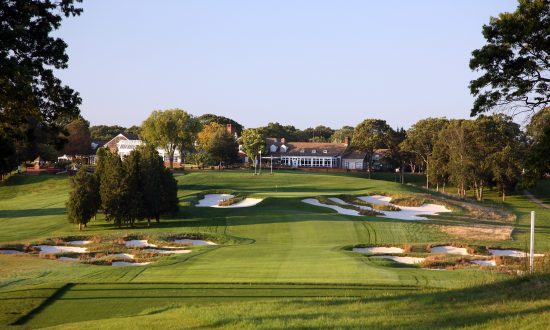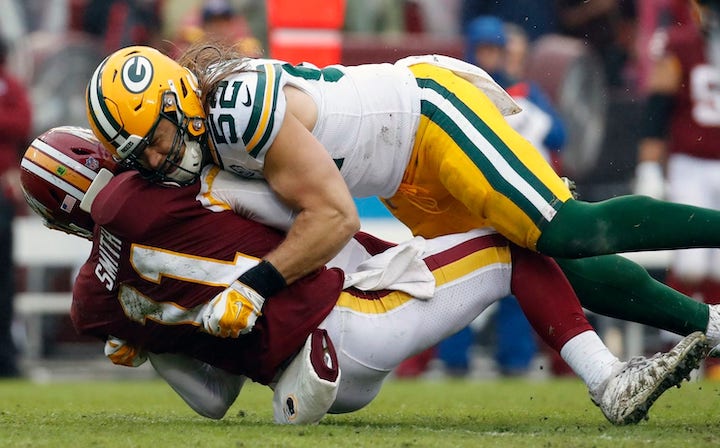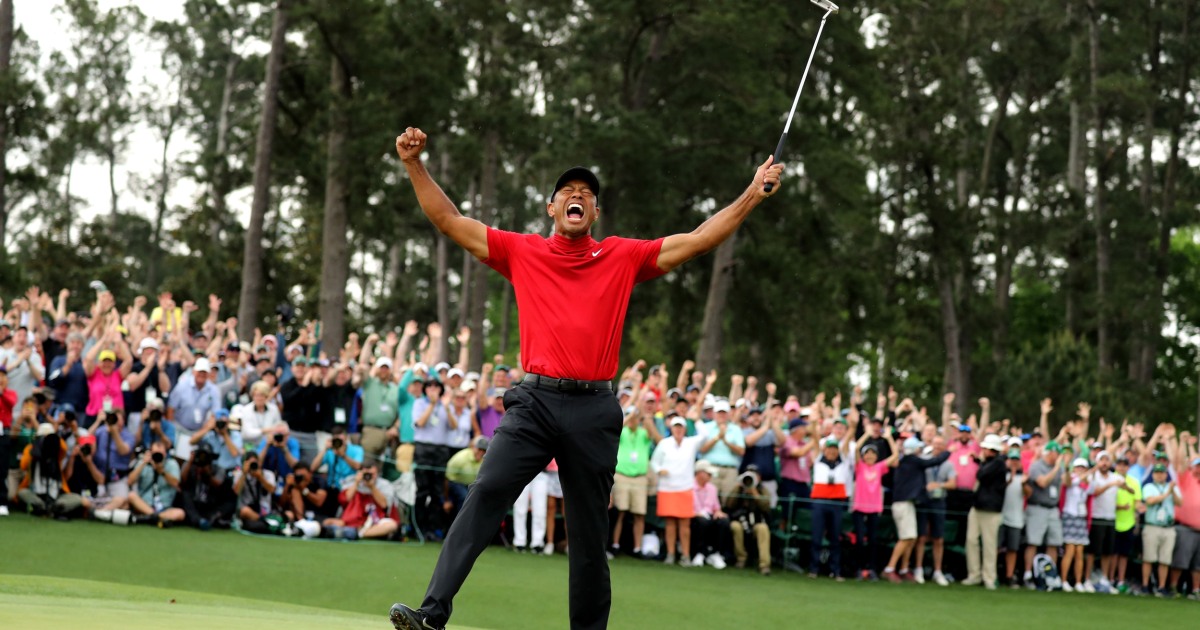To be completely honest, it’s been difficult for me to get excited about this year’s draft. Normally, draft season is the best. It begins in January, with the college football postseason, where we get to see some of the most highly-touted prospects on a national stage. Then you have the Senior Bowl and the East-West game, where scouts fall in love with prospects based on less than a week’s worth of work. All of this was moving along according to plan with nothing standing in the draft’s way.
Then obviously something got in the way. The scouting combine was overshadowed by mass hysteria and nationwide concern, and after that, everything else was canceled. There were no pro days, so none of the injury-riddled athletes from the combine got to put out their official numbers. There were no real ‘official visits’ for prospects, so it’s a bit more difficult to see who teams are specifically looking at this year. And now apparently the draft is going to look like a shitty EA video game. The only good thing that’s come out of all this is the fake “Pro Days” that prospects are holding for themselves, where they magically shave .3 seconds off of their official combine-timed 40.
With all of this said, there are still plenty of reasons to get excited about this year’s draft. I can guarantee a trade in the Top 10 of the draft, with the Lions and Giants holding picks 3 and 4, dangling the hopes of drafting Tua Tagovailoa over the Dolphins and Chargers’ respective heads. Four teams have multiple first-rounders this year: the Dolphins, Jaguars, Raiders, and Vikings. I wouldn’t count out a trade-up for any organization except for the Vikings. Even though this draft will be conducted through computers, there will still be plenty of action in the first round. So without further ado, here are my predictions for the first round.
1. Cincinnati Bengals – Joe Burrow, QB, LSU
Although there are some believers in Tua over Joe Burrow, I know there’s not much to overthink here. Joe Burrow just had one of the most dominant seasons that we’ve ever seen by a pure pocket passer in college, winning every major award, including the National Championship. He rolled through secondaries that were full of NFL talent in Alabama and Clemson, and he showed very few moments of weakness. He’s accurate, calm under pressure, and has enough arm talent to be a great NFL quarterback. The Bengals are lucky that they chose this year to completely suck. Just kidding, they suck every year.
2. Washington Redskins – Chase Young, EDGE, Ohio State
Taking Chase Young here is a no-brainer. I understand that cornerbacks have slightly more positional value than edge rushers. I understand that if they believe that Tua is an upgrade over Dwayne Haskins, they could take him. But Chase Young is the right pick. His draft profile is among the likes of Myles Garrett, Von Miller, and Jadeveon Clowney. The only difference is, he was twice as productive as any of them in college. Unless the Washington front office has literally zero faith in Haskins, Young HAS to be the pick here. He is as close as you can get to a guaranteed perennial All-Pro player.
3. Miami Dolphins (From DET) – Tua Tagovailoa, QB, Alabama
I’m not one for making trades in Mock Drafts, but it is so obvious that there’s going to be a trade in the Top 5. With two QB-needy teams sitting behind Detroit, they’d have to be completely incompetent not to have a bidding war for their pick, which would be the right to Tua Tagovailoa. Tua is a smart, athletically gifted, and productive player. There’s not much more you can ask for from a QB. The only ‘knock’ on Tua is that he played with too much NFL talent in his college career.
As you can see, there are two Alabama WRs picked in the rest of this mock, and there’s an OT from ‘Bama too. I don’t think that playing with too much talent is negative unless these receivers were consistently bailing Tua out of bad situations (ex.: Johnny Manziel and Mike Evans), but this was rarely the case. Tua maximized the production of his offense in Alabama, and I think he’ll be able to take command of an NFL offense with equivalent efficiency.
Trade Details: DET Receives: 5, 26, 56, ’21 R2, ’21 R4. MIA Receives: 3, 85, ’21 R5.
4. New York Giants – Andrew Thomas, T, Georgia
This pick honestly feels like a toss-up to me. The best player available here is clearly Jeffery Okudah, who I believe will be a franchise CB. However, the Giants have invested an insane amount of capital in the cornerback position over the past two years. They spent a first-round pick on Deandre Baker, and they completely overpaid James Bradbury, so it seems like they’ll be looking elsewhere with their fourth pick. A glaring need of theirs is at tackle with the aging Nate Solder at LT and an unsolved RT spot. Andrew Thomas was a stalwart for the Georgia Bulldogs over the past two seasons, he has prototypical LT size, and he hasn’t shown any glaring weaknesses. I wouldn’t be surprised if Dave Gettleman settled for Thomas here.
5. Detroit Lions (From MIA) – Jeffery Okudah, CB, Ohio State
This year’s draft has the potential to be a grand slam for the Detroit Lions. They most likely will trade out of their third spot. If they manufacture a trade that lands them only two spots back to five, they’ll get the guy they would’ve picked at three anyways. After trading superstar cornerback Darius Slay, they have a glaring need for an outside cornerback. If they can luck into Okudah here, they’ll have one of the most dangerous CB groups in the league, with Okudah and Desmond Trufant outside the numbers, and Justin Coleman at slot. Okudah was an absolute lockdown cornerback at Ohio State this past year, maintaining high levels of production against teams like Clemson and Penn State. He tested well at the combine and is as smooth of an athlete that you’ll see at the CB spot. He’ll be a perfect replacement for Slay.
6. Los Angeles Chargers – Justin Herbert, QB, Oregon
After losing the bidding war for Tua, the Chargers will have to ‘settle’ for Justin Herbert. Herbert’s production doesn’t jump off the screen, but that’s okay. He’s as NFL-ready as they come; he has a great arm, he does well under pressure, and he doesn’t have too many concerns with accuracy. If you compare him to some of the most recent rookie QB’s taken in the 5-10 range (Josh Allen, Daniel Jones), you’ll realize that the Chargers are actually getting pretty good value here. And if you doubt that Los Angeles will be looking for a QB here, I don’t know what to tell you. The only person that believes that Tyrod Taylor is a long-term solution is Tyrod Taylor. Out of all the QB-needy teams in the draft, I think that the Chargers would be the best situation for a young QB. You couldn’t ask for much more as far as weapons go. Herbert gets to stay on the west coast, and he gets to live in Los Angeles. I don’t see a better place for the Oregon kid to go.
7. Carolina Panthers, Isaiah Simmons – LB/S/EDGE, Clemson
I want this pick to happen so badly. With the sudden and devastating retirement of Luke Kuechly, the Panthers have a gaping hole at linebacker. They also have to fill a spot at safety. They also need a better DB for their nickel&dime packages. Isaiah Simmons is one player that could account for all three of those needs. Simmons is a modern defensive Swiss Army Knife; he played about 11 different positions on Clemson’s defense. He showed his ability to rush the passer, fill gaps as a run-stuffing linebacker, and to play centerfield as a safety. He’s an absolute unicorn, and in any other draft he’d be a Top-5 pick. The Panthers would be blessed if he fell to them. Oh, by the way, he’s 6’4″, 238lbs, ran a 4.38 40, and had a 39 inch vertical.
8. Arizona Cardinals – Tristan Wirfs, T, Iowa
This is a relatively easy pick to predict. There’s uncertainty as to who the Cardinals will take here specifically, but it’ll be an offensive tackle. Their offensive line is a complete disaster, but the rest of their offense is actually pretty damn good, especially after they fleeced Bill O’Brien out of DeAndre Hopkins. Tristan Wirfs consistently mauled Big-10 edge rushers this year, and he’s an athletic freak. The Cardinals will be able to plug him into their offensive line immediately. If Arizona can hit on this pick, I’ll be really excited to see how their offense evolves over the next few years.
9. Jacksonville Jaguars – Jerry Jeudy, WR, Alabama
Once again, a team benefits from a loaded Top-10. I feel like I’ve already said this a couple times, but Jerry Jeudy should be a Top-5 pick. He would be in most draft classes. Over the course of his Alabama career, he dominated defensive backs with his superior physical profile, superior route running, and an extraordinary knack for winning contested catch battles. He’s as much of a sure thing as you can get at receiver, and he would be a perfect weapon for sophomore QB Gardner Minshew. Jeudy can stretch the field with his speed, he has above-average RAC ability, and he can also work as a possession receiver in the middle of the field. He’s a bit thin, but if he fills out in the NFL, he’ll have a prototypical WR1 frame.
10. Cleveland Browns – Ceedee Lamb, WR, Oklahoma
After trading for perennial All-Pro LT Trent Williams, the Cleveland Browns have somehow figured out their offensive line since the season ended. This opens the door for them to improve their already lethal receiving corps. As the league has become almost universally pass-first, most NFL offenses consider three wide receivers to be starters. The Browns are missing a solid third option for Baker Mayfield. Adding Ceedee Lamb to their offense would create an elite receiving trio with Jarvis Landry and Odell Beckham. Lamb would actually be reuniting with Mayfield after the both of them played at Oklahoma. Lamb shows very few weaknesses in his game. He has prototypical size, he’s lethal in the open field, and he’s a creative and refined route runner. This pick could catapult the Cleveland offense into one of the NFL’s elite.
11. New York Jets – Jedrick Wills Jr., T, Alabama
After doing Sam Darnold no favors over the first few years of his career, the Jets have to do something to help. Their receiving corps is a mess, their offensive line situation is less than ideal, and Adam Gase cannot be trusted. Rolling into 2020 with an unproven second-year right tackle and a left tackle that didn’t even start on the Seahawks(!) cannot be good for Sam Darnold’s confidence. If the Jets actually want to build something with Darnold at QB, they need to invest capital in their O-Line and their WRs. They could go with Henry Ruggs here to replace Robby Anderson, but I just think that Jedrick Wills is a safer pick for them. He’s played against the grown-ass men of the SEC for a couple years (and he dominated), and he protected Tua’s blindside as well as anyone could. He was also a superb run-blocker, creating power and leverage that’ll translate to the NFL. This would be a solid pick for New York.
12. Las Vegas Raiders – Henry Ruggs III, WR, Alabama
The Raiders could go one of three ways here. In my opinion, I would trade back, letting a team jump the Buccaneers and 49ers to draft Henry Ruggs. The Raiders are in desperate need for depth at cornerback and wide receiver. They already have another first round pick, and if they could get two picks in the 20-45 range plus later capital for #12, Mike Mayock could hit an absolute home run with this draft. The value of this draft for receivers and corners is in the 20-45 range, so it’s almost a no-brainer to trade back, maybe pickup a Tee Higgins/Denzel Mims and a Jeff Gladney/Bryce Hall type guy. If they decide not to trade back, I would take Henry Ruggs III here. It’s a bit of concern that he hasn’t received a ton of volume on his Alabama team over the past couple years, but he has game-breaking speed and very few concerns with his actual level of play. He’s an elite deep threat with a clean and consistent release and 4.27 speed. He would open up the field for the Raiders, and they could have elite talent at every level of the field with Josh Jacobs, Darren Waller, and Ruggs.
13. San Francisco 49ers – Derrick Brown, DT, Auburn
This is a stupid pick, and I don’t like it. The 49ers have needs in their secondary, interior offensive line, and wide receiver. The problem with that is the lack of value at each of those positions at #13. Henry Ruggs would be an absolute perfect pick for them here. Hopefully he falls to them, but if he doesn’t, they’d probably have to take the best player available here then address WR at pick 31. Derrick Brown was a monster at Auburn. San Francisco would be the perfect spot for him. They need a space eating DT, and he’d face little to no pressure due to the 49ers’ already loaded defensive line. He’d see about zero double teams next year, which is a lot different from what he saw while in the SEC. He’d be a solid pick for the 49ers here, but if Ruggs is off the board, I wouldn’t be surprised to see San Francisco trade back.
14. Tampa Bay Buccaneers- Josh Jones, T, Houston
This draft is for Tom Brady. This draft is to get him more weapons, more protection, to make sure that the GOAT is happy in his first year away from New England. Once again, Henry Ruggs would be the ideal pick here. However, the Bucs also have the 45th pick. I’m confident that they could get a K.J. Hill or a K.J. Hamler to stretch the field for Tom Brady and co. So with their first rounder, they could address the eyesore they’ve had at tackle for a few years. With the choice between Josh Jones and Mekhi Beckton, I’d be inclined to say that Tampa would go with the safer option. Jones had an extremely productive year at Houston, giving up four sacks+qb hits+hurries on 635 total snaps. The Buccaneers should be content with taking the safe route at tackle here.
15. Denver Broncos – Kristian Fulton, CB, LSU
The Broncos had a sneaky-good offseason. Their offensive line is young, but they’re set for a few seasons. They acquired Jurrell Casey and his contract for pretty much nothing. Now they have five Top-100 picks, and they’re ready to get some weapons for Drew Lock. Ideally they’ll trade up from 15 to 10, giving up 15, a third, fourth, and maybe a future third to the Browns. Jerry Jeudy or Ceedee Lamb would be a perfect complement for Courtland Sutton, but if they’re not able to do that, that’s okay. They can address their mess of a cornerback group in the first and take a WR later. Kristian Fulton is a corner with fantastic instincts, and any CB that has consistent success in the SEC should have little problems adjusting to the NFL.
16. Atlanta Falcons – C.J. Henderson, CB, Florida
I have mixed feelings about the Falcons right now. They have little cap flexibility, and have major concerns at several valuable positions. But then again, this is what happens when you have a quarterback that makes >$35 million/year. After trading Desmond Trufant they have nothing at corner; no offense to Jordan Miller and Isaiah Oliver. C.J. Henderson is a prototypical man cover corner with elite physical traits. He’s not as consistent as you’d like a CB1 to be, but at 16 you can’t ask for much more.
17. Dallas Cowboys – Xaiver McKinney, S, Alabama
If McKinney falls to the Cowboys I’d be ecstatic. I’m not saying it’s unlikely, I just think he’s a perfect fit for them. He’s the total package as far as the safety position goes, he has deep coverage skills, he can be used in blitz packages, and he can move into the slot CB role if needed. He actually reminds me a lot of another Alabama safety, Minkah Fitzpatrick. For a team that is in desperate need of more talent in the secondary, McKinney should be their guy. I think McKinney and Grant Delpit are on the same tier as far as talent goes, but I think McKinney’s versatility makes him a more intriguing prospect.
18. Miami Dolphins – Grant Delpit, S, LSU
With the second of their three first-round picks, the Dolphins are free to pick the best player available. Kind of. I think Javon Kinlaw is probably the best player available here as far as class value and talent goes, but the Dolphins used their first on a d-lineman last year, so I’d think that they’d go in a different direction this year. Grant Delpit is a rangy, tall safety that can cover as well as any safety in this class. He has elite instincts in the passing game, and his length and speed will translate well to the NFL.
19. Las Vegas Raiders – A.J. Terrell, CB, Clemson
The Raiders are in need of another man-to-man corner. It’s no secret that Gruden and Mayock love defensive players from Clemson. Put those two ideas together, and you have Las Vegas selecting A.J. Terrell with their second first rounder. He tested extremely well at the combine, and even though it may look like he was exposed by Ja’Marr Chase in the national championship, the tape on Terrell is kinder than expected. He’s a fluid athlete, he’s got good technique for a man corner, and I think the Raiders could plug him in as a day-1 starter in 2020.
20. Jacksonville Jaguars – Javon Kinlaw, DT, South Carolina
It’ll be interesting to see if Kinlaw actually falls in the draft like this. He probably won’t. I honestly think that it’s more likely that Kinlaw is selected in the Top 13 of this draft. He’s all the way down to twenty just because it’s hard to justify taking a defensive tackle that high unless he’s a game-wrecker like Aaron Donald. Defensive tackle is a position that’s becoming more and more replaceable, and Kinlaw is suffering from this. Kinlaw was an extremely effective pass-rusher at South Carolina, and he has potential to be a cornerstone piece for the Jaguars’ defensive rebuild. He has incredible athleticism for his size (6’6″ 302), I think he’ll be a quality starter for years.
21. Philadelphia Eagles – Laviska Shenault Jr., WR, Colorado
This is where the wide receivers start to fly off the board. As far as talent and NFL project-ability, I have most of these wide receivers pretty close to each other. It now comes down to fit. The Eagles need every type of receiver aside from a deep threat. And they also need a deep threat because Desean Jackson is like 50. Laviska Shenault has been on scouts’ radar since his sophomore year, as his ability to win contested catches has made for some impressive highlight tapes. He’s not just a jump-ball guy though. He has speed, and he’s as dangerous as anyone with the ball in his hands. He didn’t get much work from the slot at Colorado, but I think it’s easier for receivers to transition from outside the hashmarks to inside the hashmarks (Due to the lack of press). The Eagles have been building an offense around Carson Wentz for years, and Shenault should be one of the final pieces.
22. Minnesota Vikings – Tee Higgins, WR, Clemson
The Vikings have been waiting quite a while to get rid of Stefon Diggs and his twitter antics. They waited for the perfect year, where they could use a late first round pick to select a wide receiver that could go Top-10 in a weaker class. Tee Higgins has been the number one option for one of the nation’s best offenses for two years. Even with all this attention from the NCAA’s best defenses, he still produced at a high level. He has a fantastic blend of height, speed, route-running nuance, and ability to win at the point of the catch. He’s a wideout with very few weaknesses, and I think he’d fit perfectly with the Vikings; where he has an above-average QB, and another good wide receiver to take the attention off of him.
23. New England Patriots – Patrick Queen, LB, LSU
Here’s the first true reach of the draft. Obviously the Patriots have very few weaknesses, Bill Belichick is one of the greatest team-builders of this generation. They have a need for playmaking wideouts, but they can address that more effectively in the middle rounds. They do however have a glaring need for an athletic inside linebacker. Queen is a modern linebacker, specializing in coverage as opposed to run defense. In his last year at LSU, he was moved all around their defense, taking snaps as a pass rusher, slot CB, and even safety. His versatility would be maximized in New England, making him a solid pick at 23.
24. New Orleans Saints – Trevon Diggs, CB, Alabama
The Saints have the most complete roster in the NFL. They have an offensive powerhouse that only got stronger after adding Emmanuel Sanders, and their defense has an above-average pass rush and secondary. Trevon Diggs was my pick here because the Saints need depth at corner, and if you add elite talent to a position that’s already solid at, you do so. Janoris Jenkins is their CB2, and he’s obviously not a long-term answer. Trevon Diggs is a press specialist, and he can lock down deep routes as well as anyone. He’s also violent at the point of attack, in regards to contested catches. He’s long and crafty, but he’s not an incredibly smooth athlete. The Saints could utilize his unique skill set correctly and make him an impact player.
25. Minnesota Vikings – Jaylon Johnson, CB, Utah
After playing it safe and drafting Tee Higgins at 22, I’m inclined to think that the Vikings would take a bigger risk at pick 25. Jaylon Johnson reminds me of Marcus Peters: he’s extremely instinctual and physical, which ends up causing some extreme positives and negatives. He’s a smart player though, which is what allows him to play a sort of reckless style at cornerback. In his 1,256 cover snaps at Utah, he gave up three touchdowns.(PFF) He has a few weaknesses that’ll be ironed out in the pros, but he has the potential to be a game-changing player from outside the hashmarks.
26. Detroit Lions (From MIA) – A.J. Epenesa, EDGE, Iowa
I don’t think that Epenesa will fall this far. But Detroit is an awesome fit for him and I like to fantasize. He’s extremely technically sound, and he understands the leverage game at an elite level. He doesn’t have the burst that you’d want from an edge rusher, but he can win with a big arsenal of pass rushing moves and pure strength. He’s big, strong, and he can defend at a high level against the pass and the run. He’s like Diet J.J. Watt, and that is easily good enough. He’d be perfect for Detroit, who runs a scheme that needs defensive ends that aren’t just pass-rushing specialists.
27. Seattle Seahawks – Curtis Weaver, EDGE, Boise State
Will the Seahawks take another edge rusher at the end of the first round? Yes. The addition of L.J Collier did little to nothing for Seattle’s pass rush. If they let Clowney walk, I’m reluctant to believe that Collier and a 32 year-old Bruce Irvin will provide an effective pass rush for a team that’s trying to contend for a Super Bowl. Curtis Weaver’s athleticism is severely lacking, and he’s not as fit as you’d want an NFL edge rusher to be. He produced on an otherworldly level at Boise State though, racking up 38 sacks over his three years of college football. He gives me big Jarvis Jones vibes, hopefully he can get into shape in the NFL.
28. Baltimore Ravens – Julian Okwara, EDGE, Notre Dame
This would somewhat be a steal for the Ravens. The Ravens just need someone to rush the passer. That’s all they need. He’ll do exactly what the Ravens need at a very high level, and not much else. His run defending isn’t great, but that doesn’t matter. The Ravens have Calais Campbell, Brandon Williams, and Derek Wolfe for that. Okwara is strong and fast, and he consistently pressured the passer at a high rate. He never really converted his pressures into sacks at a high rate, but once again, that doesn’t really matter.
29. Tennessee Titans – Mehki Becton, T, Louisville
This is another strange pick. I wouldn’t bet on this pick happening. I personally wouldn’t be comfortable spending a first-round pick on Becton, but he’s such an athletic marvel that a team is bound to take a swing on him early. He was moderately productive at Louisville, and some of his highlights are like watching Orlando Pace manhandle guys at Ohio State. Sometimes though his technique is lacking, and he gives up leverage easily due to his titanic frame. Tennessee has a need at right tackle, and Becton was exclusively a LT for Louisville this year. However, he did play RT during his Sophomore year.
30. Green Bay Packers – Jalen Reagor, WR, TCU
It’s time that the Packers get Aaron Rodgers more receiving help. I know it’s a controversial take, but I had to say it. Scooping random guys off the street to play wideout for them has worked in the past, but enough is enough. Jalen Reagor is an electric player, with game-breaking speed and an unmatched ability to change direction. He’d put some juice into the Green Bay offense, which is exactly what they need.
31. San Francisco 49ers – Denzel Mims, WR, Baylor
In a perfect world, the 49ers would get someone that can really stretch the field at #31. Denzel Mims ran a 4.38 second 40 at the combine. He can stretch the field. He has the perfect frame for the modern receiver (6’3″ 205), and his athletic profile is so elite that he can work pretty much anywhere on the field. He does have some pretty apparent weaknesses though. His hands are a problem (12.9 drop %), and he doesn’t have an expansive route tree. He’d be perfect for San Francisco though. He won’t be expected to run the route tree of a first option, or even a second option. He’ll be there to take the top off of a defense, and he’ll win contested deep balls. He could truly add another dimension to the 49ers’ offense.
32. Kansas City Chiefs – Kenneth Murray, LB, Oklahoma
To cap off the first round, the defending Super Bowl champs will be addressing the only hole in their roster. Damien Wilson and Anthony Hitchens are simply not the answer for them at linebacker. Not only are they not productive or particularly talented, they are slow. Slow inside linebackers have pretty much been phased out of the NFL in the name of pass coverage. Kenneth Murray is explosive, and he had one purpose at Oklahoma: hunt players at his level of the field, from sideline to sideline. He does need to improve his intelligence as a football player, he’s a bit slow in reading offenses and route combos, but his speed kind of makes up for it. KC would be good for him, he could learn from one of the smartest defensive players in the league in Tyrann Matheiu.

